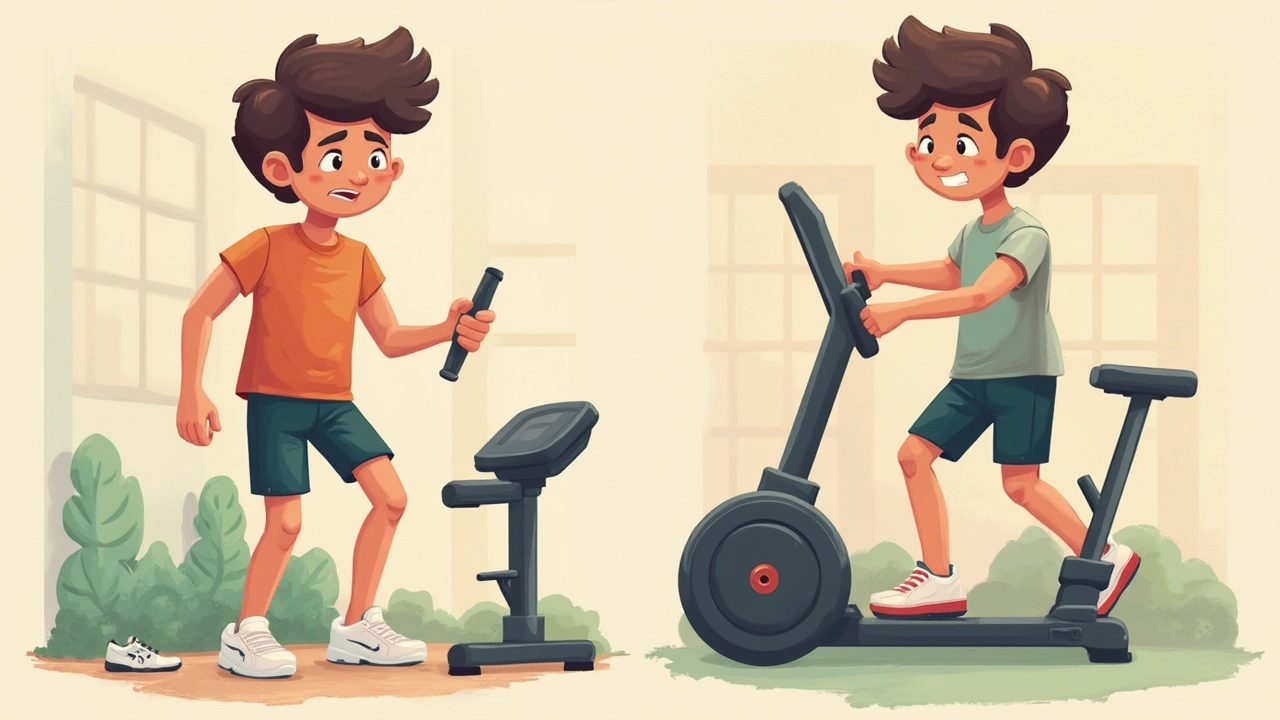Is Working Out 2 Hours a Day Too Much? What You Need to Know
 May, 28 2025
May, 28 2025
First time you see someone at the gym for hours, you might wonder—am I slacking or are they overdoing it? Two-hour workouts sound intense, right? But whether it’s too much really depends on your goals, your lifestyle, and how your body responds.
Some folks, especially pro athletes or fitness junkies, can handle longer gym sessions. They plan their routines, take breaks, work in different muscle groups, and stay serious about sleep and nutrition. For the rest of us, though, two hours a day can actually backfire. It could mean you’re skipping recovery, inviting nagging injuries, or just burning out mentally.
What’s often overlooked is how much quality matters more than sheer time. Someone crushing an hour with focus and good form will get more out of it than a two-hour wander through the gym scrolling their phone. We're told more is better, but with workouts, doubling up can mean twice the soreness—not twice the gains.
- 2 Hours in the Gym—Healthy or Overkill?
- Who Can (and Can’t) Handle Long Workouts
- Trouble Signs: When Your Body Says Enough
- Smarter Habits for Maximum Results
2 Hours in the Gym—Healthy or Overkill?
Two hours at the gym sounds like dedication, but does it actually put you ahead— or way behind? The short answer: most people don’t need to spend that much time doing working out to get solid results. The American College of Sports Medicine says most adults should aim for about 150 minutes of moderate exercise or 75 minutes of intense cardio per week. That breaks down to just 30-60 minutes a session, not hours on end each day.
If you push past an hour of focused lifting or cardio, your benefits start dropping off. Hormones like cortisol rise if you stay in high gear too long, making it harder to build muscle and lose fat. There’s also more risk of getting injured if your mind checks out or your form slips toward the end of a marathon workout.
But there are exceptions. Elite athletes, bodybuilders in a cutting phase, or people prepping for an event (think marathon or competition) sometimes hit those 2-hour marks with careful planning. They split workouts—maybe one hour cardio, one hour weights—and make recovery an absolute priority. They’re also watched by coaches, often have massage therapy, and usually have years of training behind them.
For most everyday people, slogging through a two-hour daily grind isn’t just hard to stick with, it’s straight-up unnecessary. More isn’t always better when it comes to the gym. You’re better off going in with a plan, dialing in your intensity, and actually leaving time for your body to recover. Quality really beats quantity here—and your future self will thank you for it.
Who Can (and Can’t) Handle Long Workouts
So, is working out for two hours straight right for everyone? Not even close. It really comes down to your fitness level, what you’re training for, and how seriously you’re taking your recovery. Pro athletes? They’re in a different league. They often split their training into chunks across the day, and they've built up to those long sessions over years. Their bodies are used to pounding it out, and their schedules are packed with professional recovery routines—think ice baths, massages, and strict meal plans.
For regular folks—students, parents, desk jockeys, or weekend warriors—two hours in the gym every day is usually over the top. Most people don’t have the time or energy to recover properly or fuel up like pros. The result? You might start losing strength, get cranky, or find simple soreness turning into annoying injuries.
- Fitness newcomers: You want to start way smaller. Jumping into marathon sessions trick your body into thinking working out is punishment, not something to look forward to. Stick with sessions 30 to 60 minutes, tops.
- Intermediate lifters: If you’ve got a few years of consistent training, you can stretch workouts on certain days—but two hours still feels long unless you’re really focused (say, doing both weights and cardio with proper breaks).
- Endurance folks: If you’re training for something wild—like a marathon or Ironman—you might see your sessions extend beyond 90 minutes. That’s always paired with planned rest days and an eye on nutrition.
- Athletes: For them, hitting the two-hour mark can make sense, because it’s their job. But even they break up sessions and have experts watching their backs.
If your main goal is to lose fat, gain some muscle, or just move better, you can hit almost all your targets with shorter, more intense gym workouts. Researchers in the American Journal of Sports Medicine found that as little as 150 minutes per week (just over 20 minutes a day) can noticeably improve health and body composition.
Here’s how different people stack up when it comes to handling long workouts:
| Type | Can They Handle 2-Hour Workouts? | Best Approach |
|---|---|---|
| Complete Beginner | No | Short, consistent training (30-45 minutes) |
| Intermediate Gym-Goer | Maybe (occasionally) | Focus on good form, split routines if longer |
| Endurance Athlete | Yes (with periodization) | Longer cardio, proper fueling, rest days |
| Professional Athlete | Yes | Structured by coaches, daily recovery plans |
The most important thing? Listen to your body, and don’t assume longer is always better. The working out sweet spot means you leave the gym feeling worked—not wiped out for the next two days.

Trouble Signs: When Your Body Says Enough
This is where it gets real. Plenty of people push past what their body can handle, thinking more sweat equals more results. But too much time at the gym isn’t always a badge of honor. There are clear warning signs your body will throw at you if you’re overdoing it, and ignoring them is asking for trouble.
Let’s start with the basics: if you’re constantly sore, not just the good kind after a solid session but soreness that lingers for days, that’s a big clue. Your muscles need time to rebuild, and if they never catch a break, your progress slows way down. Another red flag? Your energy levels tank. If you’re dragging all day and a simple set of stairs feels like running a marathon, it’s a sign to dial it back.
It’s not just physical stuff either. Mood swings, trouble focusing, or that blah feeling about even going to the gym can all be side effects of overtraining. If you notice you’re getting sick more often, that’s your immune system waving a white flag. According to sports medicine research, chronic overexercising can spike your stress hormones, making it easier to catch colds or even get injured.
- Restless nights or trouble falling asleep, even if you’re exhausted
- Weird aches and pains that stick around
- Unusual weight loss or gain, even when your eating habits haven’t changed
- Workouts feel harder than before instead of getting easier
If even a few of these are true, take it seriously. Your body’s basically yelling, “Enough!” Give yourself permission to rest—skipping a session can actually help you get stronger in the long run.
Smarter Habits for Maximum Results
Dumping more hours into your working out routine isn’t the hack people make it out to be. If you want better results, building smart habits makes every minute in the gym count. The secret? Focus more on quality, consistency, and what science constantly proves works.
It’s easy to get dragged into endless sets, but research keeps showing the sweet spot for most people is hovering around 45-75 minutes of resistance or mixed training, about 4-5 times weekly. That’s enough time to work hard, boost muscle, and burn calories, but not so much that you fry your energy or risk injury. In fact, a 2022 study tracked recreational lifters over 12 weeks and found those who limited sessions to under an hour actually gained slightly more strength and size than those dragging it out past 90 minutes.
Want to get more bang for your buck? Here’s what changes the game:
- Plan your sessions: Don’t just wing it. Walk in with a set goal—know what lifts, weights, and reps you want. If you’re scattered, you waste time and lose focus.
- Use compound exercises: Moves like squats, deadlifts, bench presses, and pull-ups hit multiple muscle groups at once. You get more done in half the time.
- Dial in rest and sleep: You don’t get stronger in the gym—you grow when you rest. Seven to nine hours of sleep and at least a day or two of full recovery every week helps your body keep up.
- Don’t forget food: Protein helps muscles build and repair. A good rule is around 1.6–2.2 grams per kilogram of body weight per day. Carbs matter too, especially if you hit the weights hard or do lots of cardio.
- Track progress: Use an app or just a notebook. Seeing your lifts, sets, and weights go up is motivating—and shows what’s working.
Check out how different training lengths stack up for results, based on a few leading studies:
| Session Length | Training Days/Week | Average Strength Gain (%) | Injury Risk |
|---|---|---|---|
| 45-75 min | 4-5 | 15-20 | Low |
| 90-120 min | 6+ | 10-13 | Moderate to High |
| >2 hrs | 6+ | 7-9 | High |
So, instead of fighting to spend more time in the gym, flip your thinking—less really can be more when you plan, recover, and commit. Your body (and your schedule) will thank you for working out smarter, not just harder.